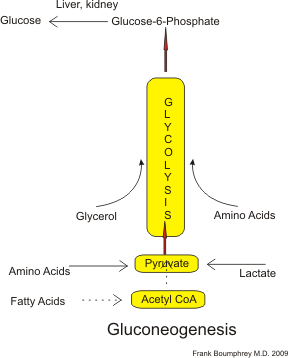Gluconeogenesis
formation of glucose from noncarbohydrate precursors, such as pyruvate, amino acids and glycerol From Wikipedia, the free encyclopedia
Remove ads
Gluconeogenesis (GNG) is a chemical process in living bodies. In gluconeogenesis, the body turns fats and proteins (glucogenic amino acids) into sugars called glucose.[1] In most animals with spines, gluconeogenesis happens in the liver, but some animals have gluconeogenesis in the kidneys.[2] gluconeogenesis usually happens when the organism has not eaten many starches or sugars or eaten nothing at all for a long time. Not eating and not eating starch can cause ketosis, which is when some cells use ketones for fuel.[3]

Remove ads
Process

- Glucogenic amino acids have this ability
- Ketogenic amino acids do not. These products may still be used for ketogenesis or lipid synthesis.
- Some amino acids are catabolized into both glucogenic and ketogenic products.
In humans, the main gluconeogenic compounds are lactate, glycerol (a part of the triglyceride molecule), alanine and glutamine. They are involved in over 90% of the overall process.[5]
Lactate comes back to the liver where it is converted into pyruvate by the Cori cycle using the enzyme lactate dehydrogenase. Pyruvate, the first designated substrate of the gluconeogenic pathway, can then be used to make glucose.[6]
Fat is mostly broken down, but if there is no fat to break down, or the body cannot access the fat stores, then proteins found in the muscle can break down, resulting in muscle loss.[7]
Remove ads
References
Wikiwand - on
Seamless Wikipedia browsing. On steroids.
Remove ads
